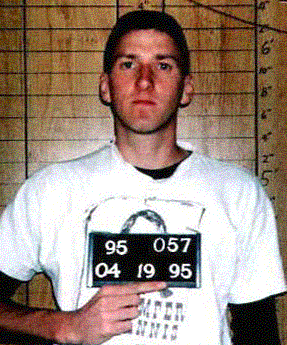
Prosecutor Joseph Hartzler began his opening statement in the Timothy McVeigh trial by reminding the jury of the terror and the heartbreak: "Ladies and gentlemen of the jury, April 19th, 1995, was a beautiful day in Oklahoma City -- at least it started out as a beautiful day. The sun was shining. Flowers were blooming. It was springtime in Oklahoma City. Sometime after six o'clock that morning, Tevin Garrett's mother woke him up to get him ready for the day. He was only 16 months old. He was a toddler; and as some of you know that have experience with toddlers, he had a keen eye for mischief. He would often pull on the cord of her curling iron in the morning, pull it off the counter top until it fell down, often till it fell down on him. That morning, she picked him up and wrestled with him on her bed before she got him dressed. She remembers this morning because that was the last morning of his life...."
A bomb carried in a Ryder truck exploded in front of the Murrah Federal Building in Oklahoma City at 9:02 a.m. on April 19, 1995. The bomb claimed 168 innocent lives. That a homegrown, war-decorated American terrorist named Timothy McVeigh drove and parked the Ryder truck in the handicap zone in front of the Murrah Building there is little doubt. In 1997, a jury convicted McVeigh and sentenced him to death. The federal government, after an investigation involving 2,000 agents, also charged two of McVeigh's army buddies, Michael Fortier and Terry Nichols, with advance knowledge of the bombing and participation in the plot. Despite considerable evidence linking various militant white supremacists to the tragedy in Oklahoma City, no other persons faced prosecution for what was--until September 11, 2001--the worst act of terrorism ever on American soil.
The Oklahoma City bombing trials raise questions more interesting than the answers they provide. How, in four years, can an army sergeant and Green Beret aspirant turn so violently against the government he served? If there had been no Waco, would there have been no Oklahoma City? Did McVeigh want to be captured? Why did the government only bring charges against three men in connection with the bombing, when compelling evidence suggests that others played significant roles in the crime? We do not have clear answers to any of these questions--but some possible answers to these and other intriguing questions have come into better focus in the years since the McVeigh and Nichols trials.
The Making of an American Terrorist
The childhood of Timothy McVeigh in Lockport, New York was far from idyllic. His parents divorced in 1978, when Tim was ten, and for the remainder of his school years he lived mainly with his father, Bill McVeigh. Scrawny and nonathletic, "Noodle" McVeigh became a target for neighborhood bullies. He attributes a lifelong hatred for bullies of all kinds (a class which, in his view, included an overreaching federal government) to early beatings on softball diamonds and head spinning "swirlies" in flushing toilets. It is possible that McVeigh's fascination with guns, dating to preteen years spent admiring his grandfather's 22-caliber rifle, might have something to do with his view of weapons as the great equalizer. He dedicated himself to developing his marksmanship skills, spending hours shooting holes in soft drink cans in a ravine. By age 14, Tim McVeigh's interests included survivalism. He began stockpiling food and camping equipment in preparation for possible nuclear attack or a communist overthrow of the United States government.
Although McVeigh performed well on standardized tests in high school, school and its social life had considerably less appeal for him than his world of guns, fringe movements, and science fiction books. He struck classmates as somewhat introverted and disengaged, and his only extracurricular activity was track. Under the entry "future plans" in his high school yearbook, McVeigh wrote: "Take it as it comes, buy a Lamborghini, California girls." Despite his reference to "California girls," McVeigh seemed uncomfortable around women, never had a girlfriend, and--despite his own contentions to the contrary-- might have remained a virgin throughout his entire life.

For two years following high school graduation, McVeigh briefly attended a computer school in Buffalo and took on a series of short-term jobs--then, in May 1988, he enlisted in the U. S. Army. In basic training, the loner McVeigh found a friend in his platoon leader, Terry Nichols, who shared his conservative and somewhat paranoid political views. McVeigh seemed to fit well into the structured life of the military, performing well enough to be promoted to sergeant. He served in Fort Riley, Kansas, where he met Michael Fortier, the man who would later provide key testimony against him in the Oklahoma City bombing trial. From Fort Riley, McVeigh headed to the Persian Gulf War, where for four months he drove a Bradley Fighting Vehicle and, for his efforts, earned a bronze star. McVeigh seemed well-suited to the details of military life; his army years were probably his best years. Nonetheless, after realizing that he lacked the "right stuff" during the first day of a Green Beret try-out, McVeigh requested and received an honorable discharge in December 1991.
McVeigh's life darkened in the year following his discharge. By the end of 1991, McVeigh was living with his father again in upstate New York, near Buffalo, and working for near minimum wage as a security guard. He fought through bouts of serious depression and thoughts of suicide. Politically, he moved further and further from the mainstream. He began espousing increasingly angry views of U. S. foreign policy, gun control, and what he believed were conspiracies involving the United Nations. In a March 1992 letter to the Lockport Union-Sun, McVeigh wrote, "AMERICA IS IN DECLINE....Do we have to shed blood to reform the current system?" According to McVeigh, he first began thinking of violent action against the federal government in August 1992 following news of a federal government shoot-out with survivalist Randy Weaver in the Idaho woods.
In January 1993, McVeigh turned in his security company badge, sold most of his belongings, packed his bags, left New York, and began a transient life of gun shows, stays with army buddies, and short-term jobs. Gun shows provided McVeigh with money and a steady stream of acquaintances who shared his anti-gun control and anti-government views.

McVeigh being interviewed by a reporter in Waco in 1991 (Merville/Gamma Liason)
No event did more to radicalize McVeigh than did the stand-off near Waco, Texas between members of the Branch Davidians, a religious cult headed by David Koresh, and U. S. Bureau of Alcohol, Tobacco, and Firearms (BATF). On February 28, 1993, 80 armed BATF agents tried to execute a warrant to search for illegal weapons at the Mount Carmel compound of the Davidians. The raid ended badly, with four agents and six Branch Davidians killed. What would turn out to be a 51-day stand-off began. The federal government's actions so infuriated McVeigh that he traveled to Texas in March to sell bumper stickers with slogans such as "Fear the Government that Fears Your Gun." McVeigh was watching television at the farm of his army buddy, Terry Nichols, in Michigan on April 19 when the government forces (including the FBI and army) launched their attack against the heavily fortified Davidian compound. Tanks rammed holes in the compound and agents fired CS gas inside. Pyrotechnic devices fired into the building turned it into a raging inferno. When it was over, 74 men, women, and children were found dead inside the compound. McVeigh, in Michigan, sat stunned and appalled: "What is this? What has America become?" He decided the time would come when he would strike back.
The Widening Conspiracy
There is no shortage of people in the United States who have serious beefs with the federal government. In addition to the anti-gun control crowd, there are anti-tax fanatics, white supremacists who resent government's race and immigration policies, and a wide variety of persons who think the United States government is full of communists or "one-world-government" proponents.
Timothy McVeigh had most of these complaints with the government, and over the next two years would find himself in the company of many who shared much of his somewhat paranoid world view. At an April 1993 gun show in Tulsa, for example, McVeigh met Andreas Strassmeir, the grandson of a founder of the Nazi party and then the head of security for Elohim City, a 400-acre compound on the Arkansas-Oklahoma border founded by a white supremacist. (There is interesting, but inconclusive, evidence suggesting that Strassmeir might have been a federal undercover operative.) In Kingman, Arizona, McVeigh renewed his friendship with army buddy Michael Fortier, an anti-gun control protester with a passion for far-right politics. In the fall of 1993, McVeigh and Terry Nichols made their first visit to Elohim City, a hotbed of anti-government activity--including a plot to blow up a federal building in Oklahoma City. (For McVeigh, it would be the first of at least two, and most likely four or more visits to the compound.)
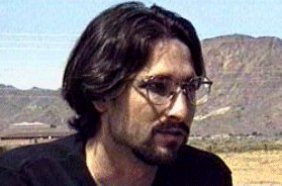
Michael Fortier
In 1994, McVeigh's activities became overtly criminal. According to FBI reports, it is probable that McVeigh participated in a series of bank robberies around the Midwest with a gang from Elohim City in an effort to raise money for projects involving anti-government violence. McVeigh cased banks, and most likely drove the getaway car in some of the heists. He also plotted and carried out, with the help of either Nichols or Elohim City residents, an armed robbery of an Arkansas gun dealer that he had befriended at various gun shows. Joined by Michael Fortier, he stole various items from an Arizona National Guard armory.
Some of McVeigh's activities bordered on the bizarre. He turned his modest Arizona home into a bunker, renounced his U. S. citizenship, and began making and exploding homemade bombs. (According to a book by two inmates who later shared death row with McVeigh, his recipe for the bomb he would use in Oklahoma City came from a patriot friend, who used his chemistry degree from the University of California as a Meth manufacturer.) About this same time, McVeigh's own use of methamphetamines increased. He became increasingly vocal in promoting his apocalyptic world view. In July 1994, he and Michael Fortier trespassed on to "Area 51," a top secret government reservation for weapons testing located near Roswell, New Mexico. Two months later, he journeyed to Gulfport, Mississippi to investigate a rumor that the town had become a staging area for United Nations troops and equipment.
A farewell letter written by McVeigh in July to his boyhood friend, Steve Hodge, revealed the evolution of his thinking: "I have sworn to uphold and defend the Constitution against all enemies, foreign and domestic, and I will....I have come to peace with myself, my God, and my cause. Blood will flow in the streets, Steve, Good vs Evil. Free men vs. Socialist Wannabe Slaves. Pray it is not your blood, my friend."
In September 1994, according to both McVeigh and the findings of a federal grand jury, the ex-Army sergeant began plotting to blow up the Murrah Federal Building in Oklahoma City. The date identified by the grand jury for the start of the conspiracy was September 13. On that day, McVeigh was--according to FBI records showing a receipt for a motel room in Vian, Oklahoma--visiting Elohim City, and probably participating with other anti-government activists in a series of military maneuvers. September 13 also marked the day, coincidentally or not, that a new federal law banning assault weapons became law.
By the end of September 1994, McVeigh's plot (we will, in this trial commentary, call it "McVeigh's plot," although there is a body of evidence to suggest that others played significant planning roles as well) started to unfold. On September 22, he rented a storage unit in Herington, Kansas, that would later be used to house explosive materials. A week later, Terry Nichols bought a ton of ammonium nitrate, a key ingredient in the bomb that would be used in Oklahoma City. Ammonium nitrate is a commonly used agricultural fertilizer and the purchase was made at a farm cooperative in McPherson, Kansas.
October 1994 was a busy month for McVeigh and his co-conspirators. He and Terry Nichols bought a second ton of ammonium nitrate from the same farm cooperative. A burglary at a quarry near Marion, Kansas on October 3 netted McVeigh and Nichols a supply of dynamite and blasting caps. Wearing a biker disguise, McVeigh purchased nearly $3000 work of nitromethane, a racing fuel used in bomb construction, from a Dallas track. In between these supply-gathering missions, McVeigh found time to visit Oklahoma City to inspect the building he had targeted, and to calculate his own position at the time the bomb would be likely to explode.
McVeigh also managed to fit in two separate visits in October to Kingman, Arizona. He rented another storage locker and, with Michael Fortier watching, tested the explosive mixture that he had chosen for the Murrah Building bombing. McVeigh tried to recruit Fortier to assist in the actual bombing, but Fortier balked, and asked, "What about all the people?" McVeigh told Fortier to think of the victims as "storm troopers in Star Wars" who, although individually innocent, "are guilty because they work for the evil empire." Despite the persuasive efforts of McVeigh, Fortier made clear that he had no desire to be in Oklahoma City on the day of the bombing.
McVeigh's close association with white supremacists and other government-haters at Elohim City continued throughout 1994. In addition to joining in bank robberies, there is evidence to suggest that people at the compound were involved in the bombing plot itself. According to BATF informant Carol Howe, who worked undercover in Elohim City, Andreas Strassmeir and Dennis Mahon made the first of three trips to Oklahoma City in November to inspect possible bombing targets. Howe informed her supervisor of these developments. The BATF was sufficiently alarmed by Howe's reports to plan a raid on Elohim City, but following a February 1995 meeting with officials from the FBI and U. S. Attorney's Office, the planned operation is called off. There is no way of knowing whether the raid, if conducted, might have prevented the tragedy in Oklahoma City--but that remains a real possibility.
In March 1995, when Terry Nichols told McVeigh that he wanted to back out of the bombing plan, McVeigh had to turn elsewhere for the assistance he would need in the final stages of the plot. There is speculation that his help came from Elohim City. (McVeigh wanted to be seen at the mastermind of the plot, and in his statements discounted the role of others in the conspiracy, leaving uncertainty as to exactly what roles others played. A polygraph test taken by McVeigh showed him to be truthful in regards to his own role in the bombing, but "evasive" concerning the roles played by other persons not charged in the bombing.) Fellow death row inmates David Hammer and Jeffrey Paul, in their 2004 book Secrets Worth Dying For, contend that McVeigh revealed to them that he and four members of the Aryan Republican Army, with Elohim City connections, met several times in March and April 1995 in the Arizona desert, where "they conducted 'dry runs' of the 'planting the bomb and getting away.'" The two authors also contend that McVeigh told them he met in Las Vegas a man he called "Poindexter," who provided detailed knowledge on bomb assembly, and would visit with him again at McVeigh's room at the Imperial Hotel in Kingman.
On April 5, two minutes after a phone call to the Ryder Rental Company made from his motel room in Kingman, McVeigh placed a call to Elohim City. The contents of that phone conversation are unknown, of course, but there has been considerable speculation in books and on Internet sites, that McVeigh sought to coordinate bombing plans with some compound residents. Three days after his phone call, McVeigh arrived in Oklahoma, where he was seen at Lady Godiva's, a Tulsa strip club, in the presence of Elohim City militants Andreas Strassmeir and a third man, who some people suggest might have been Michael Brescia. A security camera in a dressing room at the strip club apparently recorded McVeigh telling a stripper, "On April 19, you'll remember me for the rest of your life."
In the final days leading up to the bombing, Aryan Republican Army members (and perhaps bomb expert "Poindexter") converged in east central Kansas where final preparations were being made. (This is a matter of dispute, as the trial record only hints at this possibility and McVeigh told authorities otherwise, but a growing body of evidence suggests several Elohim City activists played critical roles in April 1995. This history is supported by the chronology of events reported in Secrets Worth Dying For, based on McVeigh's alleged death row revelations. Any book written by convicted death row inmates raises credibility concerns, but the inmates' account corresponds fairly well with the timing of various sightings of "John Doe No. 2" and other unidentified persons, as reported by witnesses interviewed by the FBI.) The men most likely camped at Geary Lake, the same place where McVeigh said he received some cash from Terry Nichols on April 14, before he checked into room 25 at the Dreamland Motel in Junction City. A Junction pizza delivery man later told an FBI interviewer that he delivered a pizza to "Bob Kling" in room 25 that night--and that the man taking the pizza was not Timothy McVeigh. "Bob Kling" was, most likely, ARA member Scott Stedeford.
On Easter Sunday, April 16, McVeigh , Nichols, and (probably) "John Doe #2" drove to Oklahoma City. McVeigh and John Doe #2 drove in McVeigh's newly purchased Mercury Marquis, while Nichols followed behind in his pickup. McVeigh parked the old Marquis, which was to be his getaway car, in a lot near the Murrah Building, and then rode back to the Dreamland Motel with Nichols and John Doe #2.
On the afternoon of April 17, McVeigh pulled out of Elliot's Body Shop in Junction City with a Ryder rental truck. In a form he filled out at Elliot's, McVeigh said he planned to use the truck for a four-day trip to Omaha. McVeigh left the Dreamland Motel in the Ryder truck about 4:30 the next morning.
Stories of what happened next diverge considerably. Either alone (one story) or after picking up Brescia (another story), McVeigh drove to his Herington storage locker where he (or they) met (depending on which account you believe) either bomb expert Poindexter or Terry Nichols. (According to Secrets Worth Dying For, McVeigh said Nichols was "a no-show" at the locker. McVeigh is said to have complained, "He and Mike [Fortier] were men who liked to talk tough, but in the end their bitches and kids ruled.") The men--whoever they were--loaded bags of fuses and drums of nitromethane into the truck. In his authorized biography, McVeigh claimed that he and Nichols also loaded bags of fertilizer into the truck and then completed the assembly of the bomb later that morning at Geary Park. In this version of events, McVeigh set off alone later that afternoon, heading south down I-35 for Oklahoma. He parked the Ryder truck for the night near Ponca City, Oklahoma, sleeping in the cab.
(In his alleged prison revelations to inmates, on the other hand, McVeigh reportedly said that the fertilizer had previously been loaded into a second "decoy" truck, and that two trucks--not one--were driven to Oklahoma City that afternoon. Assembly of the bomb was said to have been completed that night at a warehouse in the Oklahoma capital city with the help of Poindexter, McVeigh, and A.R.A. member Richard Guthrie. In this far more dramatic version of events, related in Secrets Worth Dying For, Poindexter was killed by a throat slashing administered by an A.R.A. member after bomb assembly was completed. The explanation given to McVeigh for the killing: "Soldier, he was only hired help, not one of us.")
FBI interviews provide some support for each of the conflicting stories. The couple who own the Santa Fe Trail Diner in Herington, the site of McVeigh's storage locker, told federal interviewers that they saw McVeigh, Nichols, and a third man who resembled John Doe #2 having breakfast in their establishment around 8 a.m. on the morning before the bombing. Witnesses also reported seeing a Ryder truck and another pickup truck at Geary Lake an hour or two later. Owners of a steakhouse in Perry, Oklahoma told agents they saw McVeigh and "a stocky companion" eat dinner in their restaurant around 7 in the evening. What to make of these various sightings? We might never know exactly who assisted McVeigh in the 24 hours leading up to the dreadful events of April 19, but the McVeigh-and-McVeigh-alone theory, and the McVeigh-and-just-Nichols theory, both seem to stretch credulity.
April 19, 1995
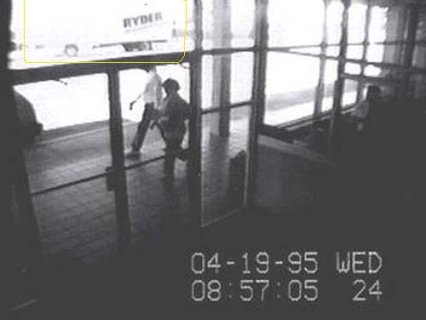
A surveillance camera captures an image the Ryder truck being driven by McVeigh, just minutes before the truck blows up in front of the Murrah Federal Building
For Timothy McVeigh, April 19 stood out as a date with multiple historical meanings. It was, probably foremost to the former visitor to Waco, the date in 1995 that the federal government launched its attack on the Branch Davidian compound in Texas, with the horrific loss of life that resulted. McVeigh also knew April 19 to be the date in 1775 that the Battle of Lexington occurred, marking the beginning of the armed uprising by colonialists against British control. In his getaway car, McVeigh included a bumper sticker that he expected--probably wanted--authorities to find. The bumper sticker carried the quote of Revolutionary War patriot Samuel Adams, "WHEN THE GOVERNMENT FEARS THE PEOPLE, THERE IS LIBERTY. WHEN THE PEOPLE FEAR THE GOVERNMENT, THERE IS TYRANNY." Below the slogan, McVeigh scribbled his own words: "Maybe now, there will be liberty!" April 19 of 1995, McVeigh also certainly knew, was to be the scheduled day of execution in Arkansas for a white supremacist Richard Snell, formerly of Elohim City, who had--years earlier--targeted the Murrah Building in Oklahoma City as the site for a potential bombing.
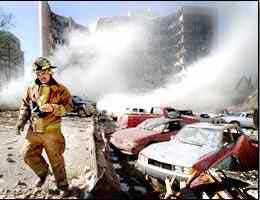
On the morning that he would become the greatest mass murderer in American history, McVeigh chose to wear a T-shirt with a drawing of Abraham Lincoln and the words shouted by John Wilkes Booth after his assassination of the president, "SIC SEMPER TYRANNIS" ("thus ever to tyrants"). In the version of events related by McVeigh in his authorized biography, American Terrorist, he began driving south in his Ryder truck from Ponca City about 7 a.m. on the morning of April 19, having made an "executive decision" to move up the scheduled timing of the bombing. In the more sensational version of events related in Secrets Worth Dying For, McVeigh, with Michael Brescia in the passenger seat of the Ryder truck, left an Oklahoma City warehouse around 8 a.m. At 8:45, McVeigh pulled the truck into an Oklahoma City tire store to ask directions. According to the store employee who talked with McVeigh, a second man wearing a baseball cap sat in the passenger seat of the vehicle as McVeigh sought directions to a downtown address six blocks away. A video camera at 8:55 a.m. captured the Ryder truck as it headed toward the center of downtown Oklahoma City. The Ryder truck drove up NW 5th street shortly before 9:00. McVeigh lit two fuses. He parked the truck in the handicapped zone in front of the Alfred P. Murrah Federal Building, locked the vehicle, and strode quickly away in the direction of a nearby YMCA building. At 9:02 a.m., shortly after many parents had dropped their toddlers off at the Murrah Building's second-floor daycare center, the bomb exploded, taking with it much of the building, killing 167 people, injuring another 509, and changing forever the lives of thousands of Oklahomans. (The damage to the building was so extensive that many people believe there were in fact two blasts--the second coming from an ATF secure area where explosives being stored (illegally) were ignited by the truck bomb. Both seismic evidence and witness testimony supports the "two blast theory.")
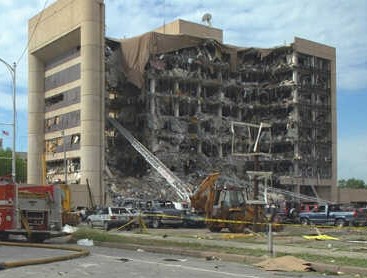
Two news stories that followed the bombing reported raised interesting questions concerning a wider conspiracy. In Arkansas, prison officials reported that in the days preceding April 19, Richard Snell repeatedly told them to expect a big bombing or explosion on the day of his execution. Execution came for Snell exactly twelve hours after the Oklahoma City bombing. Meanwhile, in Spokane, Washington, the local paper reported that Chevie Kehoe, a former Elohim City resident staying at a motel in the city, woke early on April 19 to demand that the motel owner turn the lobby television to CNN, telling him that "something is going to happen and it's going to wake people up." The motel owner said that Kehoe became ecstatic when news of the Oklahoma City bombing was announced. "It's about time!" Kehoe is reported to have exclaimed.
About 80 minutes after the bombing, Charles Hanger, an Oklahoma Highway Patrol officer, noticed a McVeigh's Mercury driving north on I-35, about twenty miles from the Kansas border. The car carried no license plate, so the officer pulled the driver over. When McVeigh turned out to be carrying a concealed weapon without a permit, in addition to driving without a license or a vehicle registration, he was arrested, booked, and placed in the county jail in Perry, Oklahoma.
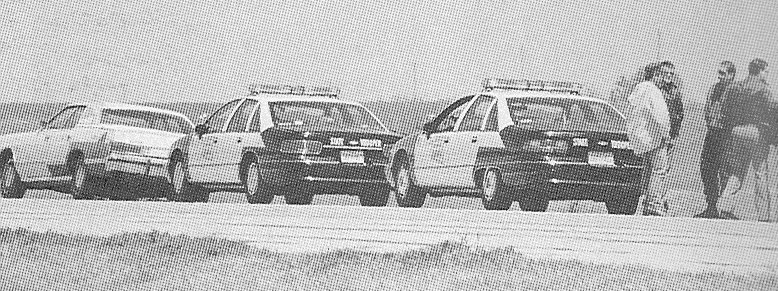
McVeigh's abandoned getaway car on I-35
Later that day, amidst the gruesome rubble of downtown Oklahoma City, federal agents found the vehicle identification number for the Ryder truck. Within hours, investigators were in a car headed for Junction City, Kansas, to see who might have rented it.
The Investigation and Trial Preliminaries
By April 21, investigatory trails had led to Timothy McVeigh and Terry Nichols. Initial speculation that the bombing was the work of Arab extremists faded away. The lead FBI investigator at Waco, Clinton Van Zandt of the FBI's Behavioral Science Unit, recognized the importance of April 19 and told other agents to look for a "white male...with military experience and ...a member of some militia group...angry for what happened at Ruby Ridge and Waco." Agents visiting Elliot's Body Shop in Junction City, the shop that rented the Ryder truck, came away with a description of renter "Robert Kling," a/k/a "John Doe No. 1," a white male with a brush cut and a strong nose. The manager of the Dreamland Motel told them that "John Doe No. 1" looked very much like Timothy McVeigh, who had rented a room at her motel in the days before the bombing. A former co-worker in New York also told authorities that "John Doe No. 1" might be the man he knew as Timothy McVeigh.
A computer check in Washington came up with information that surprised and delighted investigators: Timothy McVeigh was, at present, sitting in a Noble County, Oklahoma jail on unrelated misdemeanor charges. Federal agents traveled to Perry, where they picked up McVeigh--who had been wondering all the while what was taking authorities so long--and transported him by helicopter to Tinker Air Force Base, near Oklahoma City. Before his arraignment that evening, McVeigh met briefly with two court-appointed attorneys. "Yes," he told them, "I did the bombing."
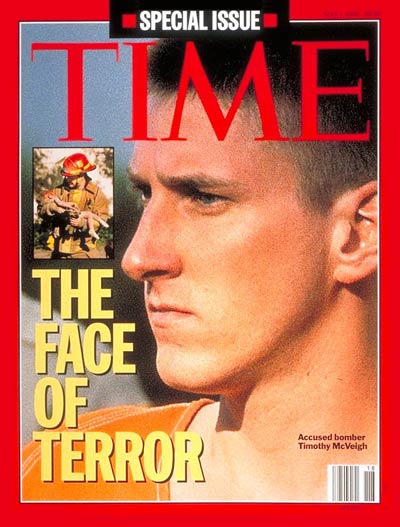
Once authorities had the name of a suspect, it wasn't difficult to identify McVeigh's army buddy, Terry Nichols, as an additional target of suspicion. McVeigh had listed the Nichols farm in Michigan as his home address. Nichols turned himself into authorities in Herington, Kansas, and consented to a search of his home. Searchers found guns, stolen goods, anti-government books, ammonium nitrate, a receipt for the purchase of the ammonium nitrate, Primadet explosive, a hand-drawn map of downtown Oklahoma City, and a telephone card used by McVeigh to make calls in his hunt for bomb-making materials.
Ultimately, the federal government would bring charges against three men: McVeigh and Nichols for conspiracy to bomb a federal building and for the murder of federal agents, and Michael Fortier for not informing authorities about the bombing and lying to federal agents about his knowledge of the bombing. Prosecutors never fully explained the decision not to bring charges against others suspected of playing significant roles in the bombing conspiracy, but apparently they simply believed they lacked the compelling evidence necessary to meet the Constitution's high "beyond a reasonable doubt" standard of guilt.
Fortier agreed to assist government prosecutors in return for not facing conspiracy charges, a promise of leniency for his admitted crimes, and the promise that his wife would not be charged. Grand jury indictments of McVeigh and Nichols came on August 11, 1995, three days after Michael and Lori Fortier presented their testimony in the case.
Fearing a fair trial was not possible in Oklahoma, U. S. District Judge Richard Matsch moved the trial to Denver. Judge Matsch also ordered that McVeigh and Nichols be tried separately, with McVeigh's trial to begin first. After receiving authorization from Attorney General Janet Reno to do so, prosecutors announced that they would seek the death penalty in both cases.
The Trial of Timothy McVeigh
Timothy McVeigh never got the trial he wanted. He tried to convince his attorneys to present a "necessity defense" that might allow him to present evidence of the "crimes" of the federal government that his bombing was meant to prevent. McVeigh believed that at least some jurors, were they to hear about the government's actions at Ruby Ridge and Waco, would find the bombing justified. (Given the carnage he caused, McVeigh's hope of sympathetic jurors seems far from realistic.) More importantly to McVeigh, a political trial might provide him the opportunity to make his case against an overreaching federal government in the larger court of public opinion.
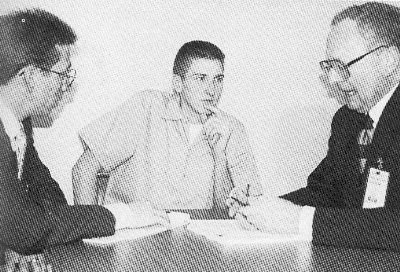
McVeigh with defense attorneys (Stephen Jones on right)
McVeigh's lead lawyer was Stephen Jones, a Republican activist who had taken on other politically charged cases. Upon his appointment as lead counsel, Jones told reporters, "My role is as old as the Constitution. Whether I perform professionally will be determined by how I conduct myself, and whether my client is satisfied..." The relationship between McVeigh and his attorney soon became strained, when McVeigh suspected Jones as being the source of a leak reported in the New York Times that McVeigh had confessed. McVeigh also resented Jones's refusal to push his "necessity defense," a decision made by Jones after research convinced him that McVeigh had no chance of establishing--as he would be required to do to raise the defense--that the federal government put McVeigh in "imminent danger."
Rather than employ a necessity defense, Jones opted for a strategy of trying to poke what holes he could in the prosecution's case, thus raising a question of reasonable doubt. In addition, Jones believed that McVeigh was taking far more responsibility for the bombing than was justified and that McVeigh, although clearly guilty, was only a player in a large conspiracy. It fit McVeigh's personality, Jones thought, for him to sacrifice himself for others who shared his anti-government cause. Jones spent considerable resources investigating McVeigh's possible ties to Arab terrorists and Andreas Strassmeir and his Elohim City associates. So much so, in fact, that McVeigh took to sarcastically calling his attorney "Sherlock Jones." "He was investigating me, not defending me," McVeigh complained.
In his book about the McVeigh case, Others Unknown: Timothy McVeigh and the Oklahoma City Bombing Conspiracy, Jones wrote: "It strains belief to suppose that this appalling crime was the work of two men--any two men...Could [this conspiracy] have been designed to protect and shelter everyone involved? Everyone, that is, except my client..." Jones considered presenting McVeigh as "the designated patsy" in a cleverly designed plot, but his own client opposed the strategy and Judge Matsch, after a hearing, ruled the evidence concerning a larger conspiracy to be too insubstantial to be admissible.
Jury selection in the McVeigh case began on March 31, 1997, a month after the appearance of a national news story reporting that McVeigh told defense investigators that he bombed the Murrah Building at the time of day he did to "increase the body count." The poorly timed leak probably came when a member of the defense team turned over to the Dallas Morning News a computer disk containing FBI reports, not knowing that the contents of their interview with McVeigh also were on the same disk. McVeigh became convinced that any chance of landing a sympathetic juror, or receiving sympathetic treatment from the judge, evaporated with the story about his interview. Over the course of three weeks, a jury of seven men and five women was chosen.
Opening statements began on April 24, in front of a packed courtroom at the Byron C. Rogers Courthouse and a closed-circuit viewing audience in Oklahoma that included many victims and their families. Lead prosecutor Joseph Hartzler, a wheelchair-bound multiple sclerosis victim, led with a dramatic opening statement that reminded jurors of the tremendous losses suffered two years earlier:
"All the children I mentioned died, and more--dozens and dozens of other men, women, children, cousins, loved ones, grandparents, grandchildren, ordinary Americans going about their business. And the only reason they died...is they were in a building owned by a government that Timothy McVeigh so hated....And the man who committed this act is sitting in this courtroom behind me. After he did so, he fled the scene--and he even avoided damaging his eardrums because he had earplugs with him."
Hartzler scornfully attacked McVeigh's attempts to portray himself as a modern-day patriot "like Patrick Henry and Samuel Adams." Hartzler reminded jurors that "our forefathers didn't fight British women and children; they fought other soldiers." And, he said, they fought them fair: "They didn't plant bombs, and run away wearing earplugs."
In his opening statement for the defense, Stephen Jones charged that the government conducted a hasty two-week investigation of the actual bombing and then spent the next two years zeroing in on his client. Critical evidence was ignored, Jones charged, such as the eyewitness testimony of bombing victim Daina Bradley that the person she saw emerge from the Ryder truck by the federal building was black-haired, stocky, and had an olive complexion--"John Doe No. 2," not Timothy McVeigh. Jones saved his greatest wrath for star prosecution witness Michael Fortier, who he labeled as story-changing, dope-dealing conniver. Jones concluded his statement by promising jurors that by the end of the trial he would show them that his client was innocent of all charges.
The prosecution presented 137 witnesses. Some witnesses told of their own heartwrenching losses they suffered that April day. Michelle Rausch, a former journalism student, told of interviewing McVeigh as he peddled anti-government bumper stickers outside of government barricades near Waco in 1993. FBI agents described how they traced evidence found in the bombing to McVeigh. Charles Hanger of the Oklahoma Highway Patrol described his arrest of McVeigh on I-35, while other law enforcement authorities described evidence found in McVeigh's car. Tim Chambers, the Texas seller of the racing fuel nitromethane, described his dealings with the person he now knew to be McVeigh. McVeigh showed little emotion during the nearly month-long parade to the stand.
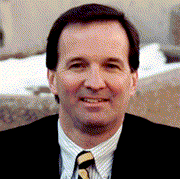
Prosecutor Joseph Hartzler
The Fortiers, Michael and Lori, filled in some of the most critical gaps in the prosecution's case. Lori Fortier admitted to some of her own failings and misdeeds, including drug use, lying to authorities, trafficking in stolen guns, wrapping blasting caps in wrapping paper, and helping McVeigh forge a driver's license. Nonetheless, she presented convincing evidence of McVeigh's key role in the bombing. For example, Lori Fortier described the day McVeigh laid about fifteen soup cans out on the floor of her trailer to illustrate the type of bombs he hoped to assemble in his truck. In his long and rambling cross-examination, Stephen Jones forced Lori to concede that she could have saved 168 lives with a simple phone call, but chose not to, and that she had been promised full immunity by the federal government in exchange for her incriminating testimony.
Michael Fortier proved to be the state's most important witness. Fortier could take jurors from the Timothy McVeigh he knew immediately after Waco, who at that time had unleashed a torrent of anti-government venom, to the one poised and ready to send a message to that same government in Oklahoma City. Fortier told jurors how McVeigh, in his living room in October 1994, had provided him with detailed plans to blow up the Murrah Building. By then, according to Fortier, McVeigh had already chosen the date for his attack to mark the second anniversary of the Waco assault. One of the most memorable moments of the trial came when Joseph Hartzler asked Fortier, "Did you have any discussion [with Tim McVeigh] about the deaths that such a bomb would cause?" Fortier replied, "I asked him about that... I said, 'What about all the people?' And he explained to me, using the terms from the movie "Star Wars" -- he explained to me that he considered all those people to be as if they were the storm troopers in the movie "Star Wars." They may be individually innocent; but because they are part of the -- the evil empire, they were -- they were guilty by association." Fortier also revealed his own reaction, when he first heard the news from Oklahoma City: "Oh my God, he did it."

The most painful testimony for McVeigh probably came from his own sister, Jennifer McVeigh. Her obvious reluctance to offer testimony that hurt her brother made what she did say all the more damaging. Jennifer outlined for jurors her brother's evolution from a government critic to a militant poised to take violent action against what he saw as a lawless government. She revealed that he told her of his experience with explosives, as well as the ominous words that ended one of his last letters to her: "Won't be back forever."
The defense presented 25 witnesses over just a one-week period. The most effective witness for the defense might have been Dr. Frederic Whitehurst, who provided a damning critique of the FBI's sloppy investigation of the bombing site and its handling of other key evidence. Unfortunately for McVeigh, while Whitehurst could show that FBI techniques made contamination of evidence possible, he could not point to any evidence (such as trace evidence of explosives on the shirt McVeigh wore on April 19) that he knew to be contaminated.
The task of the defense team was all but impossible. They could not come up with a single alibi witness. They faced the reality that McVeigh had told dozens of people of his hatred of the government, and had told a friend that he planned to take violent action on April 19. Rental agreements and a drawing of downtown Oklahoma City linked him to the blast. He carried earplugs in his car driving north from Oklahoma City forty minutes after the explosion. How could it all be explained away?
In his closing argument, Jones pointed the jury to what the prosecution didn't have, such as an eyewitness that placed him near the Murrah Building around 9:00 a.m. on April 19, or the lack of McVeigh's fingerprints on the ignition key for the Ryder rental truck recovered in the bombing investigation. The Fortiers' lacked credibility, Jones said, they were just out to save their own skins. For a sympathetic defendant charged in a less heinous crime, poking holes in a prosecution case can sometimes be enough. Not in this case, however.
After over twenty-three hours of deliberation, the jury returned its verdict: guilty on all eleven counts. McVeigh sat expressionless at the defense table as the verdict was read.
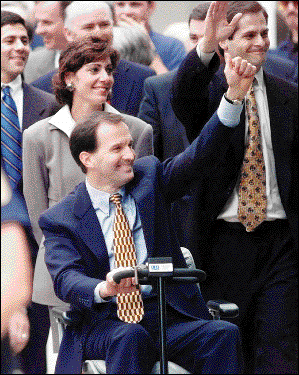
Prosecution team celebrates its victory
The same jury listened to evidence in the penalty phase of the trial, with McVeigh's life hanging in the balance. Much of the testimony did not make for easy listening. Stories of heartbreak and loss, told by victims and rescue workers and medical personnel. Doctors told of sawing off legs of people trapped under the rubble. WiVes told of husbands who would never see their children graduate or get marries. Firefighters described recurring nightmares they had experienced since the tragedy. Police officers described finding dead babies in what was once the second-floor daycare center at the Murrah Building. In the face of this powerful testimony, testimonials from McVeigh's army buddies and the argument of Stephen Jones that his client was not motivated by hatred of the victims paled in comparison. The last two witnesses for the defense probably were its strongest, Timothy's divorced parents, Bill and Mickey McVeigh. Mickey cried as she read a statement she had composed the previous night. She told jurors that Tim was "a child any mother could be proud of; I still to this day cannot believe he would have caused this devastation." Bill McVeigh introduced a fifteen-minute videotape showing his young son meeting Santa Claus, playing with his toy train, and appearing to be a normal, all-American boy. "I love Tim," Bill McVeigh said simply.
For two days, the jury discussed McVeigh's fate. On Friday, June 13, 1997, the jury's decision was announced: death. Two months later, McVeigh returned to Judge Matsch's courtroom to hear the formal pronouncement of his sentence. Asked by the judge if he had anything to say, McVeigh quoted from a 1928 dissenting opinion by Supreme Court Justice Louis Brandeis: "'Our government is the potent, the omnipresent teacher. For good or ill, it teaches the whole people by its example.' That's all I have." After Matsch pronounced the sentence of death, McVeigh was escorted from the courtroom by federal marshals, to be readied for transport to Florence, Colorado, the site of a federal prison known as "Supermax."
The Trials of Terry Nichols and Epilogue
Six months after McVeigh received his sentence, co-conspirator Terry Nichols escaped a death verdict in his trial before Judge Matsch. Although found guilty of conspiracy to bomb a federal building and eight counts of involuntary manslaughter, the jury acquitted Nichols on charges of using a weapon of mass destruction and first-degree murder. The jury apparently agreed with the argument of defense attorney Michael Tigar that Nichols had decided to drop out of the conspiracy some time before the actual bombing. The fact that Nichols spent April 19, 1995 at home with his family in Kansas probably figured large in the jury's decision. The jury might also have been swayed by Nichols' show of remorse--he cried at several points during the testimony--, which stood in stark contrast to McVeigh's courtroom demeanor. (In May 2004, Nichols found his life spared a second time, when a jury deadlocked on his sentence after he had been found guilty in state court in Oklahoma on 160 charges of first-degree murder.)
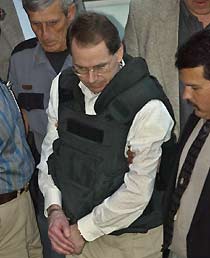
terry Nichols during his trial
In a sixteen-page letter written to Judge Matsch prior to the imposition of sentence, Nichols wrote, "If I did anything to contribute to the cause of the Oklahoma City bombing I am sorry, I'm truly sorry." He implied in his letter that he never believed McVeigh would actually go through with his bombing plan. On June 4, 1998, Nichols listened as Judge Matsch pronounced his sentence: life in prison without parole. Authorities delivered Nichols to the same Colorado prison that housed McVeigh and other celebrity inmates including Unabomber Theodore Kacyznski and the mastermind of the first attack in 1993 on New York's World Trade Center, Ramzi Yousef. (In a letter to the authors of American Terrorist, Kacyznski said he "liked" McVeigh, who he described as "an adventurer by nature" who, at the same time, was "very intelligent" and expressed ideas that "seemed rational and sensible.")
Later in 1998, Michael Fortier joined McVeigh and Nichols at the Supermax. Fortier plead guilty to lying to federal officials and failing to warn authorities of McVeigh's planned bombing. He received a twelve-year sentence. (Fortier was released from prison in January 2006, after serving ten years and six months of his sentence.)
McVeigh's appeals, as expected, met no success. In September 1999, the Tenth Circuit Court of Appeals affirmed his conviction. Six months later, the United States Supreme Court refused to hear his appeal. Authorities moved McVeigh to the only federal death row (there had been no federal executions since 1963) at a penitentiary at Terre Haute, Indiana in July 1999.
The American public got its first chance to hear directly from McVeigh in March 2000, when prison officials allowed Ed Bradley of the CBS show "Sixty Minutes" to interview him. McVeigh set only one condition for the interview: that Bradley not ask him whether he bombed the Murrah Building. He still had last-ditch appeals to think about. In the over thirty-minute interview, McVeigh offered his thoughts about politics, about his service in the Gulf War, and about what he perceived to be his unfair trial. Still, however, he showed no remorse over what happened in Oklahoma City. He blamed the U. S. government for teaching, through its aggressive foreign policy and application of the death penalty, the lesson that "violence is an acceptable option."
In January 2001, McVeigh decided to drop all his appeals and expedite his own execution. Judge Matsch set May 16 as the day he would receive a lethal injection. However, just six days before the scheduled execution, the Justice Department revealed that it found over 4,000 pages of evidence that should have been turned over to McVeigh's defense attorneys before trial, but wasn't. Attorney General John Ashcroft announced that McVeigh's execution would be postponed for one month to allow the defense to inspect the newly released documents. Angered by what he saw as another example of the government's unfairness, McVeigh at first decided to renew his appeals, but after his first appeal was rejected on June 7, McVeigh announced that he was ready to die.
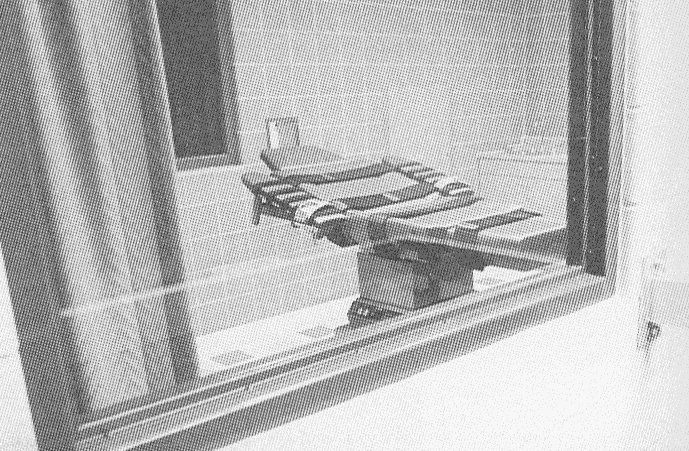
Execution chamber at federal prison in Terre Haute, Indiana
On the evening of June 10, McVeigh had his last meal (two pints of chocolate chip ice cream). The next morning, he woke early to take a shower. At 7 a.m., dressed in a shirt, khaki pants and slip-on shoes, McVeigh was led to the execution chamber. A "restraint team" strapped him to a padded gurney. The curtains over glass panels separating the chamber from a viewing area parted to allow 30 people to directly watch McVeigh's final moments, while another 300 victims and relatives gathered in Oklahoma City to watch the event on closed-circuit television. McVeigh made no final statement, but instead left a handwritten copy of the poem "Invictus," with its concluding lines, "I am the master of my fate / I am the captain of my soul." Warden Harley Lappin read an official statement and then said, "We are ready." As the drugs entered his veins, McVeigh lifted his head and made eye contact with witnesses in the viewing room. He was pronounced dead at 7:14 a.m.
Three months after his execution, on September 11, 2001, McVeigh lost his claim to having masterminded the worst terrorist attack in United States history when hijacked airplanes slammed into the two towers of the World Trade Center.
